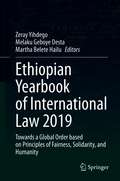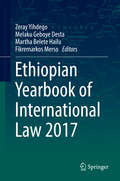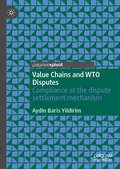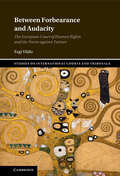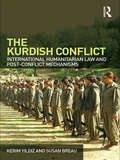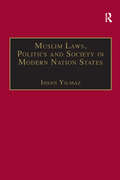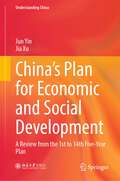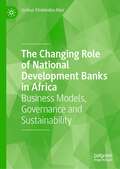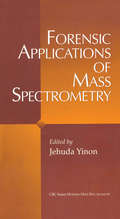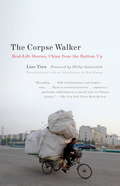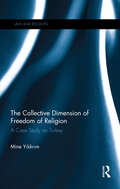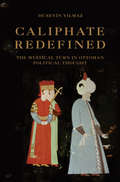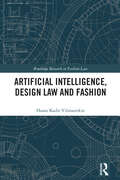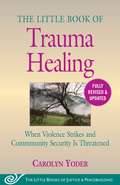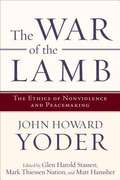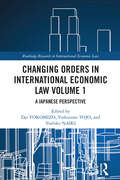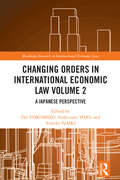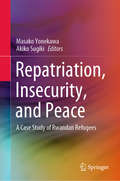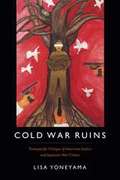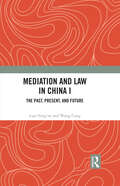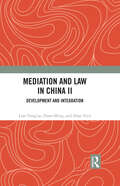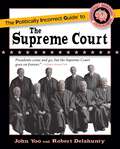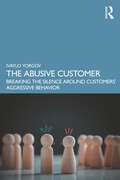- Table View
- List View
Ethiopian Yearbook of International Law 2019: Towards a Global Order based on Principles of Fairness, Solidarity, and Humanity (Ethiopian Yearbook of International Law #2019)
by Zeray Yihdego Melaku Geboye Desta Martha Belete HailuEtYIL 2019 comes out while the world is in the midst of a new coronavirus pandemic that has infected millions and killed thousands of people without distinction as to age, race, colour, or creed. As an attack on all humanity, Covid-19, the disease caused by the coronavirus, has challenged the fitness of the global order as never before, and its institutional and normative frameworks have been found wanting. As is often the case in such circumstances, when the WHO is denied resources to assist those countries or the WTO is unable to guarantee access to Covid-19 medical supplies and protective equipment, it is the poorest nations that suffer the most. EtYIL’s mission is to provide a platform for purpose-oriented scholarly analysis and debate on issues of particular significance for African countries such as Covid-19, disputes over Nile water resources, and Ethiopia-Eritrea relations. Although the pandemic came too late for this issue of EtYIL, we have managed to include two important articles that examine the subject from geostrategic and legal perspectives. EtYIL 2019 also addresses a number of other topical issues, including the responsibility of the UN Security Council (UNSC) in climate-related risks to least developed countries, the Global South’s approach to environmental protection, the challenges of international regulation of arms brokering, and the contributions of Martin Luther King, Jr. to Pan-Africanism and international human rights law. Finally, the Yearbook also continues its coverage of regional issues such as the evolving Ethiopia-Eritrea relations, Djibouti’s accession to the ICSID Convention; the trilateral negotiations between Ethiopia, Sudan and Egypt over the Grand Ethiopian Renaissance Dam and the U.S. meddling and the role of the UNSC on the issue have also been covered. As before, our contributors come from all over the world, to all of whom we extend our sincere appreciations.
Ethiopian Yearbook of International Law 2017 (Ethiopian Yearbook of International Law #2017)
by Zeray Yihdego Melaku Geboye Desta Martha Belete Hailu Fikremarkos MersoThe second volume of EtYIL brings together a number of articles and other contributions that, collectively, take EtYIL’s original mission of helping rebalance the narrative of international law another step forward. Like the first volume, this book presents scholarly contributions on cutting-edge issues of international law that are of particular interest to Ethiopia and its sub-region, as well as Africa and developing countries more generally. The major issues tackled include the interplay between national and international in the promotion and regulation of foreign direct investment in Ethiopia; the regulatory framework for the exploitation and development of petroleum resources and relevant arbitral jurisprudence in the field; the role of international law in ensuring the equitable sharing of transboundary resources, such as the waters of the River Nile, or in the delimitation of the continental shelf in the region; the efforts to establish the Continental Free Trade Area in Africa and the lessons that can be learnt from prior experiments; Africa’s policy towards the International Criminal Court and the feasibility of alternative means of serving justice in the case of grave crimes; and the UN’s peace-keeping operations in their North-South context. The issues addressed in the various contributions are mostly at the heart of live political, diplomatic and judicial activities today, and as such promise to shape the future of international law in the region and beyond. This volume not only takes a significant step further towards EtYIL’s mission, but also enriches it with fresh insights from perspectives that are not common in international law scholarship to this day.
Value Chains and WTO Disputes: Compliance at the dispute settlement mechanism
by Aydin Baris YildirimAs economic populism and protectionism increasingly threatens the global trade order, this book examines the behavior of World Trade Organization (WTO) members at the judicial arm of the WTO—the dispute settlement mechanism (DSM). The author explores why and when governments cooperate at the WTO and comply with the ruling of its panels, focusing on how the growth of global value chains through the internationalization of trade and production has increased the importance of both trade liberalization and supra-national governance and policy-making. Finding that domestic organized interests—i.e. firms and sectors—mobilize and lobby national governments to change their domestic policies to better harmonize with their international trade commitments, the author outlines how the time it takes to comply with adverse WTO rulings is shorter when the potential domestic costs of non-compliance outweigh protectionist interests. The author’s innovative research design highlights the conditions under which the WTO can preserve the rules of international trade and support a more open, global economy.
Between Forbearance and Audacity: The European Court of Human Rights and the Norm against Torture (Studies on International Courts and Tribunals)
by Ezgi YildizWhen international courts are given sweeping powers, why would they ever refuse to use them? The book explains how and when courts employ strategies for institutional survival and resilience: forbearance and audacity, which help them adjust their sovereignty costs to pre-empt and mitigate backlash and political pushback. By systematically analysing almost 2,300 judgements from the European Court of Human Rights from 1967–2016, Ezgi Yildiz traces how these strategies shaped the norm against torture and inhumane or degrading treatment. With expert interviews and a nuanced combination of social science and legal methods, Yildiz innovatively demonstrates what the norm entails, and when and how its contents changed over time. Exploring issues central to public international law and international relations, this interdisciplinary study makes a timely intervention in the debate on international courts, international norms, and legal change. This book is available as Open Access on Cambridge Core.
The Kurdish Conflict: International Humanitarian Law and Post-Conflict Mechanisms
by Kerim Yildiz Susan BreauThis book is highly topical considering the recent resurgence of violence by the PKK, the incursions into Northern Iraq by the Turkish army and security forces and Turkey's EU accession negotiations. Turkey has become an increasingly important player in Middle Eastern geopolitics. More than two decades of serious conflict in Turkey are proving to be a barrier to improved relations between Turkey and the EU. This book is the first study to fully address the legal and political dimensions of the conflict, and their impact on mechanisms for conflict resolution in the region, offering a scholarly exploration of a debate that is often politically and emotionally highly charged. Kerim Yildiz and Susan Breau look at the practical application of the law of armed conflicts to the ongoing situation in Turkey and Northern Iraq. The application of the law in this region also means addressing larger questions in international law, global politics and conflict resolution. Examples include belligerency in international law, whether the ‘War on Terror’ has resulted in changes to the law of armed conflict and terrorism and conflict resolution. The Kurdish Conflict explores the practical possibilities of conflict resolution in the region, examining the political dynamics of the region, and suggesting where lessons can be drawn from other peace processes, such as in Northern Ireland. This book will be of great value to policy-makers, regional experts, and others interested in international humanitarian law and conflict resolution.
Muslim Laws, Politics and Society in Modern Nation States: Dynamic Legal Pluralisms in England, Turkey and Pakistan
by Ihsan YilmazDrawing on theories of legal pluralism, this book tests whether and to what extent claims of the modern nation-state laws to exclusive dominance over other spheres are tenable, and reassesses the operation of law in society. Incorporating a combination of legal theory, post-modern critique and socio-legal analysis of three current jurisdictions in which Muslims play an important role, the volume identifies Muslims' current socio-legal situation and attitudes from different perspectives and reconciles them with modern legal systems in three key countries. It analyzes the conflict between the assumptions of modern legal systems and plural legal realities, and also examines attempts by modern legal systems to impose official laws in the face of resistance from unofficial Muslim laws and discusses possible responses to the challenge of dynamic Muslim legal pluralism. A valuable resource for students, researchers and academics with an interest in the areas of Islamic law and politics, and the interplay between secular law and religious/cultural traditions.
China’s Plan for Economic and Social Development: A Review from the 1st to 14th Five-Year Plan (Understanding China)
by Jun Yin Jia XuThis book reviews the basic process of China’s fourteen five-year plans with systematic theoretical overview and rich historical data and moves on to discuss the theoretical logic of plan-based state governance. The authors hold that the five-year planning system with Chinese characteristics is a flexible planning system; through adaptive macro-planning and incentive target governance, it mobilizes government, market and social forces to work together to fulfill national objectives and is a representative mechanism of the state governance system and a symbol of modernized state governance capacity. From an academic point of view, it theoretically answers questions about what, why and how concerning the five-year plans. From an interdisciplinary perspective, it explores the theoretical logic and experience of plan-based governance by combining Marxism, western theories, and the science of history. Also, it tries to represent historical facts based on a vast literature about the history of CPC and PRC, reviews historical details of the previous thirteen five-year plans, and describes the great journey of the plan preparation and implementation under the CPC leadership. This book has been published in Simplified Chinese (Peking University Press) and Traditional Chinese (Hong Kong Open Page Press). It has won the 2021 Annual Books of China Economics Education and Research Network, the first prize of excellent Works of the First Young Marxism Prize, 100 "Red Classic Reading" recommended reading books of Jiangsu National Reading Activity Leading Group celebrating the Centennial of the Founding of the Party, and Jintai Good Books of People's Daily Library.
The Changing Role of National Development Banks in Africa: Business Models, Governance and Sustainability
by Joshua Yindenaba AborThis book examines the changing role of national development banks (NDBs) in Africa. It presents a comprehensive overview of NDBs in Africa, examining their key characteristics, theoretical underpinnings, and growing importance to African economies.The book fully examines the role of NDBs and their potential to support development goals, address gaps in finance left by underdeveloped capital markets, and mobilize resources from the public and private sectors to encourage new long-term investments. Chapters cover the historical background and theoretical rationale for NDBs; the contemporary role of NDBs including their role in sustainable development, climate finance initiatives, and infrastructure development; funding sources, business models, monitoring and impact evaluation; and corporate governance, risk management and regulation. Case studies are also included to demonstrate the individual contributions of NDBs to several national economies.The book contributes to the limited literature in this area by providing a detailed resource on NDBs for scholars, students, policymakers and regulators working in the areas of development finance and banking.
Forensic Applications of Mass Spectrometry
by Jehuda Yinon Werner A. Baumgartner Wolfgang Bertsch Jean Louis Brazier Chen-Chih Cheng Bongchul Chung John T. Cody Thomas D. Donahue Dean D. Fetterolf Rodger L. Foltz Gene F. Hayes Virginia A. Hill Gunther Holzer Dongseok Lho Thomas O. Munson Jongsei Park Songja Park Henry ScholtzForensic Applications of Mass Spectrometry combines the most current developments in applications of mass spectrometry techniques to forensic analyses. The techniques discussed include:capillary-GC/MSthermospray-LC/MStandem mass spectrometry (MS/MS)pyrolysis-GC/MSisotope ratio mass spectrometryThe applications include:analysis of body fluids and hair for drugs of abusedrug testing in sportsanalysis of accelerants in fire debrisdetection of hidden explosives in luggage and mailidentification of explosives in post-explosion debrisexamination of evidential materials (paints, fibers, synthetic polymers)authentication of regulated products (flavoring substances, fruit juices)protection of industrial products by isotopic signature
The Corpse Walker
by Liao YiwuThe Corpse Walker introduces us to regular men and women at the bottom of Chinese society, most of whom have been battered by life but have managed to retain their dignity: a professional mourner, a human trafficker, a public toilet manager, a leper, a grave robber, and a Falung Gong practitioner, among others. By asking challenging questions with respect and empathy, Liao Yiwu managed to get his subjects to talk openly and sometimes hilariously about their lives, desires, and vulnerabilities, creating a book that is an instance par excellence of what was once upon a time called "The New Journalism." The Corpse Walker reveals a fascinating aspect of modern China, describing the lives of normal Chinese citizens in ways that constantly provoke and surprise.From the Trade Paperback edition.ws (conducted between 1990 and 2003) with sensitivity and patience, working both from notes and from his own memory of these remarkable conversations. The result is an idiosyncratic, powerful, and richly revealing portrait of a people, a time, and a place we might otherwise have never known.From the Hardcover edition.
The Collective Dimension of Freedom of Religion: A Case Study on Turkey (Law and Religion)
by Mine YıldırımThe right to freedom of religion or belief, as enshrined in international human rights documents, is unique in its formulation in that it provides protection for the enjoyment of the rights "in community with others". This book explores the notion of the collective dimension of freedom of religion or belief with a view to advance the protection of this right. The book considers Turkey which provides a useful test case where both the domestic legislation can be assessed against international standards, while at the same time lessons can be drawn for the improvement of the standard of international review of the protection of the collective dimension of freedom of religion or belief. The book asks two main questions: what is the scope and nature of protection afforded to the collective dimension of freedom of religion or belief in international law, and, secondly, how does the protection of the collective dimension of freedom of religion or belief in Turkey compare and contrast to international standards? In doing so it seeks to identify how the standard of international review of the collective dimension of freedom of religion can be improved.
Caliphate Redefined: The Mystical Turn in Ottoman Political Thought
by Hüseyin YılmazThe medieval theory of the caliphate, epitomized by the Abbasids (750–1258), was the construct of jurists who conceived it as a contractual leadership of the Muslim community in succession to the Prophet Muhammed’s political authority. In this book, Hüseyin Yilmaz traces how a new conception of the caliphate emerged under the Ottomans, who redefined the caliph as at once a ruler, a spiritual guide, and a lawmaker corresponding to the prophet’s three natures.Challenging conventional narratives that portray the Ottoman caliphate as a fading relic of medieval Islamic law, Yilmaz offers a novel interpretation of authority, sovereignty, and imperial ideology by examining how Ottoman political discourse led to the mystification of Muslim political ideals and redefined the caliphate. He illuminates how Ottoman Sufis reimagined the caliphate as a manifestation and extension of cosmic divine governance. The Ottoman Empire arose in Western Anatolia and the Balkans, where charismatic Sufi leaders were perceived to be God’s deputies on earth. Yilmaz traces how Ottoman rulers, in alliance with an increasingly powerful Sufi establishment, continuously refashioned and legitimated their rule through mystical imageries of authority, and how the caliphate itself reemerged as a moral paradigm that shaped early modern Muslim empires.A masterful work of scholarship, Caliphate Redefined is the first comprehensive study of premodern Ottoman political thought to offer an extensive analysis of a wealth of previously unstudied texts in Arabic, Persian, and Ottoman Turkish.
Artificial Intelligence, Design Law and Fashion (Routledge Research in Fashion Law)
by Hasan Kadir YılmaztekinArtificial intelligence (AI) now infiltrates our culture. After a couple of difficult winters, AI today is a word on everybody’s lips, and it attracts everyone’s attention regardless of whether they are experts or not. From Apple’s Siri to Amazon’s Alexa, Tesla’s auto-driving cars to facial recognition systems in CCTV cameras, Netflix’s film offering services to Google’s search engine, we live in a world of AI goods. The advent of AI-powered technologies increasingly affects people’s lives across the globe. As a tool for productivity and cost-efficiency, AI also shapes our economy and welfare. AI-generated designs and works are becoming more popular. Today, AI technologies can generate several intellectual creations. Fashion is one of the industries that AI can profoundly impact. AI tools and devices are currently being used in the fashion industry to create fashion models, fabric and jewellery designs, and clothing. When we talk about AI-generated designs, we instead focus on the fruits of innovation – more best-selling apparels, more fashionable designs and more fulfilment of customer expectations – without paying heed to who the designer is. Designers invest a lot of talent, time and finances into designing and creating each article of clothing and accessory before they release their work to the public. Pattern drafting is the first and most important step in dressmaking. Designers typically start with a general sketch on paper; add styles, elements and colours; revise and refine everything; and finally deliver their design to dressmakers. AI accelerates this time-consuming and labour-intensive process. Yet the full legal consequences of AI in fashion industry are often forgotten. An AI device’s ability to generate fashion designs raises the question of who will own intellectual property rights over the fashion designs. Will it be the fashion designer who hires or contracts with the AI programmer? Will it be the programmer? Will it be the AI itself? Or will it be a joint work of humans and computers? And who will be liable for infringement deriving from use of third-party material in AI-generated fashion designs? This book explores answers to these questions within the framework of EU design and copyright laws. It also crafts a solution proposal based on a three-step test and model norms, which could be used to unleash the authors, rights holders and infringers around AI-generated fashion designs.
The Little Book of Trauma Healing: When Violence Strikes and Community Security Is Threatened (Justice and Peacebuilding)
by Carolyn YoderHow do we address trauma, interrupt cycles of violence, and build resilience in a turbulent world of endless wars, nationalism, othering, climate crisis, racism, pandemics, and terrorism? This fully updated edition offers a practical framework, processes, and useful insights.The traumas of our world go beyond individual or one-time events. They are collective, ongoing, and the legacy of historical injustices. How do we stay awake rather than numbing or responding violently? How do we cultivate individual and collective courage and resilience? This Little Book provides a justice-and-conflict-informed community approach to addressing trauma in nonviolent, neurobiologically sound ways that interrupt cycles of violence and meet basic human needs for justice and security. In these pages, you&’ll find the core framework and tools of the internationally acclaimed Strategies for Trauma Awareness and Resilience (STAR) program developed at Eastern Mennonite University&’s Center for Justice and Peacebuilding in response to 9/11. A startlingly helpful approach.
The War Of The Lamb: The Ethics Of Nonviolence And Peacemaking
by John Howard Yoder Glen Harold Stassen Mark T. Nation Matt HamsherJohn Howard Yoder was one of the major theologians of the late twentieth century. Before his death, he planned the essays and structure of this book, which he intended to be his last work. Now two leading interpreters of Yoder bring that work to fruition. <p><p> The book is divided into three sections: pacifism, just war theory, and just peacemaking theory. The volume crystallizes Yoder's argument that his proposed ethics is not sectarian and a matter of withdrawal. He also clearly argues that Christian just war and Christian pacifist traditions are basically compatible--and more specifically, that the Christian just war tradition itself presumes against all violence.
Changing Orders in International Economic Law Volume 1: A Japanese Perspective (Routledge Research in International Economic Law)
by Dai Yokomizo Yoshizumi Tojo Yoshiko NaikiThese two groundbreaking volumes look at complex legal issues in the changing global economy from the perspective of Asia and/or Japan. Contributors scrutinize the past, present, and future and discuss what the global legal order in economic fields could be like by navigating uncertain and turbulent times. The books address six main themes: (1) Polarization and diversification of values, progress of regionalism and restructuring of multilateral rules, (2) Full-scale arrival of the digital economy and its impact, (3) Empowerment of private persons/entities, (4) Reconsideration of the concept of “territorial jurisdiction”, (5) Law of national security and rule in emergency situations, and (6) Values of Sustainable Development Goals (SDGs) in trade and investment liberalization rules. The book also examines various legal problems under the COVID-19 crisis and suggests how the post COVID-19 global economic order will be from the perspective of Asia and/or Japan. This comprehensive insight will shed light on the intertwined and complex phenomena of the world economy and allow readers of business law and international law to have a better understanding of this volatile era.
Changing Orders in International Economic Law Volume 2: A Japanese Perspective (Routledge Research in International Economic Law)
by Dai Yokomizo Yoshizumi Tojo Yoshiko NaikiThese two groundbreaking volumes look at complex legal issues in the changing global economy from the perspective of Asia and/or Japan. Contributors scrutinize the past, present, and future and discuss what the global legal order in economic fields could be like by navigating uncertain and turbulent times. The books address six main themes: (1) Polarization and diversification of values, progress of regionalism and restructuring of multilateral rules, (2) Full-scale arrival of the digital economy and its impact, (3) Empowerment of private persons/entities, (4) Reconsideration of the concept of “territorial jurisdiction”, (5) Law of national security and rule in emergency situations, and (6) Values of Sustainable Development Goals (SDGs) in trade and investment liberalization rules. The books also examine various legal problems under the COVID-19 crisis and suggest how the post-COVID-19 global economic order will be from the perspective of Asia and/or Japan. This comprehensive insight will shed light on the intertwined and complex phenomena of world economy and allow readers of business law and international law to have a better understanding of this volatile era.
Bad Girls: Sirens, Jezebels, Murderesses, Thieves & Other Female Villains
by Jane Yolen Heidi E. Y. StempleFrom Jezebel to Catherine the Great, from Cleopatra to Mae West, from Mata Hari to Bonnie Parker, strong women have been a problem for historians, storytellers, and readers. Strong females smack of the unfeminine. They have been called wicked, wanton, and willful. Sometimes that is a just designation, but just as often it is not. "Well-behaved women seldom make history," is the frequently quoted statement by historian and feminist Laurel Thatcher Ulrich. But what makes these misbehaving women "bad"? Are we idolizing the wicked or salvaging the strong? In BAD GIRLS, readers meet twenty-six of history's most notorious women, each with a rotten reputation. But authors Jane Yolen and Heidi Stemple remind us that there are two sides to every story. Was Delilah a harlot or hero? Was Catherine the Great a great ruler, or just plain ruthless? At the end of each chapter, Yolen and Stemple appear as themselves in comic panels as they debate each girl's badness--Heidi as the prosecution, Jane for context. This unique and sassy examination of famed, female historical figures will engage readers with its unusual presentation of the subject matter. Heidi and Jane's strong arguments for the innocence and guilt of each bad girl promotes the practice of critical thinking as well as the idea that history is subjective. Rebecca Guay's detailed illustrations provide a rich, stylized portrait of each woman, while the inclusion of comic panels will resonate with fans of graphic novels.
Repatriation, Insecurity, and Peace: A Case Study of Rwandan Refugees
by Masako Yonekawa Akiko SugikiThis book analyzes three major issues related to refugees: repatriation and its accompanying concerns – peace and security. Since the late 1980s, repatriation has been considered the most appropriate solution for refugees. This applies if the home country is peaceful, but often repatriation takes places in conflict situations, which can lead to national and human insecurity problems. Rwanda is one of the countries where the question of repatriation has become highly controversial since the 1990s. The United Nations maintains that Rwanda has changed significantly since the 1994 genocide, and today enjoys an essential level of peace and security. This explains why the UN has promoted repatriation and recommended the cessation of Rwandan refugee status, yet the vast majority of refugees have refused to return to the country. Providing insights from researchers, former UN staff members, journalists, and, most importantly, former Rwandan refugees themselves into both the theory and practice of refugees' repatriation as well as the security and peace issues, this book appeals to postgraduate students, academics, policymakers, and practitioners working for international organizations and NGOs.
Cold War Ruins: Transpacific Critique of American Justice and Japanese War Crimes
by Lisa YoneyamaIn Cold War Ruins Lisa Yoneyama argues that the efforts intensifying since the 1990s to bring justice to the victims of Japanese military and colonial violence have generated what she calls a "transborder redress culture." A product of failed post-World War II transitional justice that left many colonial legacies intact, this culture both contests and reiterates the complex transwar and transpacific entanglements that have sustained the Cold War unredressability and illegibility of certain violences. By linking justice to the effects of American geopolitical hegemony, and by deploying a conjunctive cultural critique--of "comfort women" redress efforts, state-sponsored apologies and amnesties, Asian American involvement in redress cases, the ongoing effects of the U.S. occupation of Japan and Okinawa, Japanese atrocities in China, and battles over WWII memories--Yoneyama helps illuminate how redress culture across Asia and the Pacific has the potential to bring powerful new and challenging perspectives on American exceptionalism, militarized security, justice, sovereignty, forgiveness, and decolonization.
Mediation and Law in China I: The Past, Present, and Future
by Liao Yong’an Wang CongAs the first volume of a two-volume set on mediation in China, this book examines the legal foundations of Chinese mediation and feasible paths to the institutionalization and professionalization of mediation.Grounded in traditional dispute resolution practices throughout Chinese history, mediation is born out of the Chinese legal tradition and considered to be “Eastern” in nature. The first volume discusses the legal principles that underpin mediation in China, rooted in a legal tradition that pursues the rule of law and morality as well as the concept of harmony in Chinese society. It first revisits traditional notions and models of Chinese mediation and then puts forward approaches to innovating the concept, institutionalization, and mechanism of mediation. The book also discusses how to promote professionalization and special legislation dedicated to mediation in China, thus establishing a mediation system that fits into and is properly tailored for Chinese society. It introduces diverse styles of mediation and social governance in different cultural contexts and demonstrates the effectiveness of China's experience in dealing with a litigious society.This title will serve as a crucial reference for scholars, students and related professionals interested in alternative dispute resolution, civil litigation, and especially China’s dispute resolution policy, law, and practice.
Mediation and Law in China II: Development and Integration
by Liao Yong’an Duan Ming Zhao YiyuAs the second volume of a two-volume set on mediation in China, this book examines the development of a diversified dispute resolution regime and other major types of mediation in China.Grounded in traditional dispute resolution practices throughout Chinese history, mediation is born out of the Chinese legal tradition and considered to be “Eastern” in nature. This second volume focuses on eight types of mediation prevalent in China in terms of its formation, development, challenges and achievements: people's mediation, court mediation, administrative mediation, industry mediation, commercial mediation, lawyer mediation, online mediation, and a combination of arbitration and mediation. In analyzing these diversified forms of mediation, the authors explain the necessity of integrating emerging forms of mediation with historical ties and traditional practice and thereby reshape a mediation system that incorporates diversified approaches, changing contexts and various dimensions including history and reality, theory and practice, state and society.This title will serve as a crucial reference for scholars, students and related professionals interested in alternative dispute resolution, civil litigation, and especially China’s dispute resolution policy, law, and practice.
The Politically Incorrect Guide to the Supreme Court (The Politically Incorrect Guides)
by John Yoo Robert J. DelahuntyJustice in the Balance Alexander Hamilton famously predicted that the judiciary would be "the least dangerous" branch of government. How's that working out? The Supreme Court stands as arbiter over a country increasingly unable to govern itself. Americans can't agree on the meaning of the Constitution or even the rule of law. Are the nine high priests enthroned in their marble temple the saviors of the Republic or the pallbearers of democracy? Are they defenders of the Constitution as written or super-legislators who make law from the bench? What did the Founders envision when they vested the "judicial Power" in "one supreme Court"? John Yoo, a professor of law at UC Berkeley, and Robert J. Delahunty, a fellow at the Claremont Institute Center for the American Way of Life, provide the answers with an incisive reading of the law and constitutional history. The Politically Incorrect Guide to the Supreme Court explains: The turbulent history of the court's early years, and the eventual triumph of "judicial supremacy" The Bill of Rights: how the Court has defined free speech, freedom of religion, and the right to bear arms The Court's notorious rulings and how they were overturned—from Dred Scott to Roe v. Wade Why "court-packing" is a constant temptation for Democratic presidents The Supreme Court's best and worst justices—and what qualities distinguished them The future of the Supreme Court: Will it be the rubber stamp of corrupt administrations or the ultimate watchdog protecting our nation's liberties? The Politically Incorrect Guide to the Supreme Court offers a penetrating and irreverent account of the justices—ideologues and cowards, geniuses and mediocrities, all of them thoroughly human—and a fascinating analysis of a Court that has swung like a pendulum from preserving the Republic to undermining government by the people and back to defending the Constitution. Sprightly, informative, and powerfully argued, this book is guaranteed to give the reader a deeper understanding of America's most powerful judicial body.
Helping Soldiers Leverage Army Knowledge, Skills, and Abilities in Civilian Jobs
by Cate Yoon Ellen M. Pint Eric J. Duckworth Jeffrey B. Wenger Jonathan Welch Laura Werber Melissa A. Bradley Michael G. Shanley Nicole H. Curtis Tepring Piquado Trinidad BelecheThis report discusses the results of occupation surveys administered to soldiers in selected Army military occupational specialties (MOSs) to assess the level and importance of the knowledge, skills, and abilities needed in these MOSs and to develop better crosswalks between military and civilian occupations. The report identifies both a broader range of military-civilian occupation matches and higher-quality matches than existing crosswalks.
The Abusive Customer: Breaking the Silence Around Customers’ Aggressive Behavior
by Ivaylo YorgovBreaking the silence around an all-too-common problem, this book offers insights into the triggers of customer aggression against service employees, explores its consequences, and provides practical advice for handling abusive customers and mitigating the damage they inflict. Today, more than half of the world’s population is employed in the service sector. This fundamental economic shift is accompanied by heightened attention to customer service and the ‘customer is always right’ paradigm. But when customers act aggressively, everyone pays a price: frontline employees, their families, their companies, and even the abusive customers themselves. Unlike breezier titles on the subject, this book is based in academic research—exploring the ‘why?’ and ‘when?’ behind abusive behavior—that underpins its practical approach, illustrated with real-world stories from professionals on the front lines of customer service. The book’s useful tools include a sample anti-customer abuse policy and management process, a cheat sheet of practices that work for handling its consequences, a summary of effective service recovery processes and practices, and abuse-handling training list and curriculum templates. Managers and workers in customer-facing roles, in industries such as retail, hospitality, tourism, banking, and contact centers, will welcome this essential resource as part of their efforts to stop aggressive customer behavior, and improve employee morale, job satisfaction, and engagement.
